WHS Compliance: SWMS Development and Implementation in Construction
VerifiedAdded on 2022/09/05
|10
|2482
|17
Practical Assignment
AI Summary
This assignment simulates a Work Health and Safety (WHS) Advisor's role in a construction scenario involving unsafe work practices at heights. The task involves completing a Safe Work Method Statement (SWMS), identifying legislative breaches, and recommending preventative measures. The solution includes a detailed SWMS, an email to the WHS committee outlining the inspection findings and proposed management plans, identification of relevant breaches of legislation and codes of practice, and a plan to address training needs, including researching Registered Training Organisations (RTOs) and calculating the total cost of training staff. Barriers to implementation are also identified, along with strategies to overcome them, emphasizing the importance of worker accountability and comprehensive WHS practices.
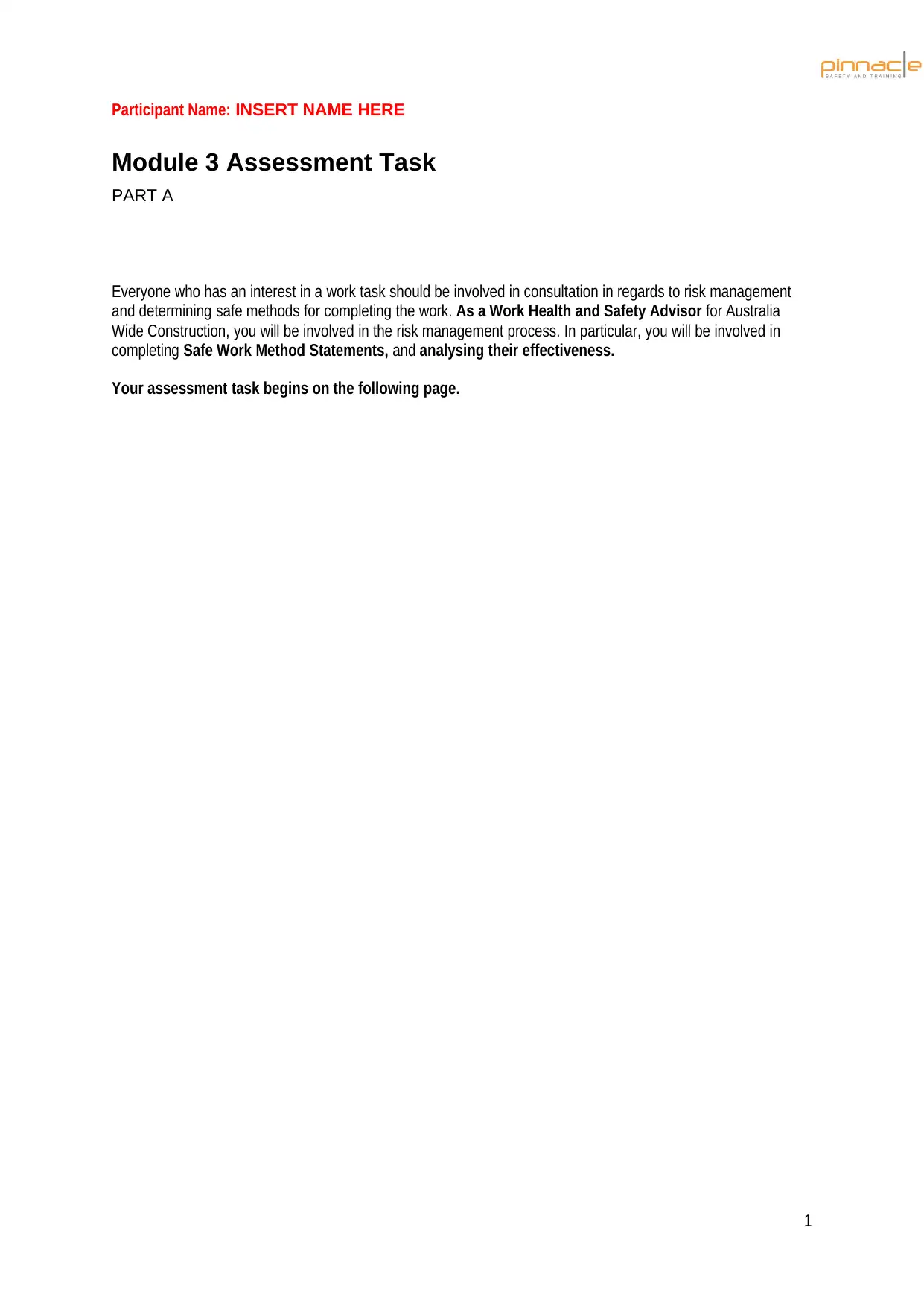
Participant Name: INSERT NAME HERE
Module 3 Assessment Task
PART A
Everyone who has an interest in a work task should be involved in consultation in regards to risk management
and determining safe methods for completing the work. As a Work Health and Safety Advisor for Australia
Wide Construction, you will be involved in the risk management process. In particular, you will be involved in
completing Safe Work Method Statements, and analysing their effectiveness.
Your assessment task begins on the following page.
1
Module 3 Assessment Task
PART A
Everyone who has an interest in a work task should be involved in consultation in regards to risk management
and determining safe methods for completing the work. As a Work Health and Safety Advisor for Australia
Wide Construction, you will be involved in the risk management process. In particular, you will be involved in
completing Safe Work Method Statements, and analysing their effectiveness.
Your assessment task begins on the following page.
1
Paraphrase This Document
Need a fresh take? Get an instant paraphrase of this document with our AI Paraphraser
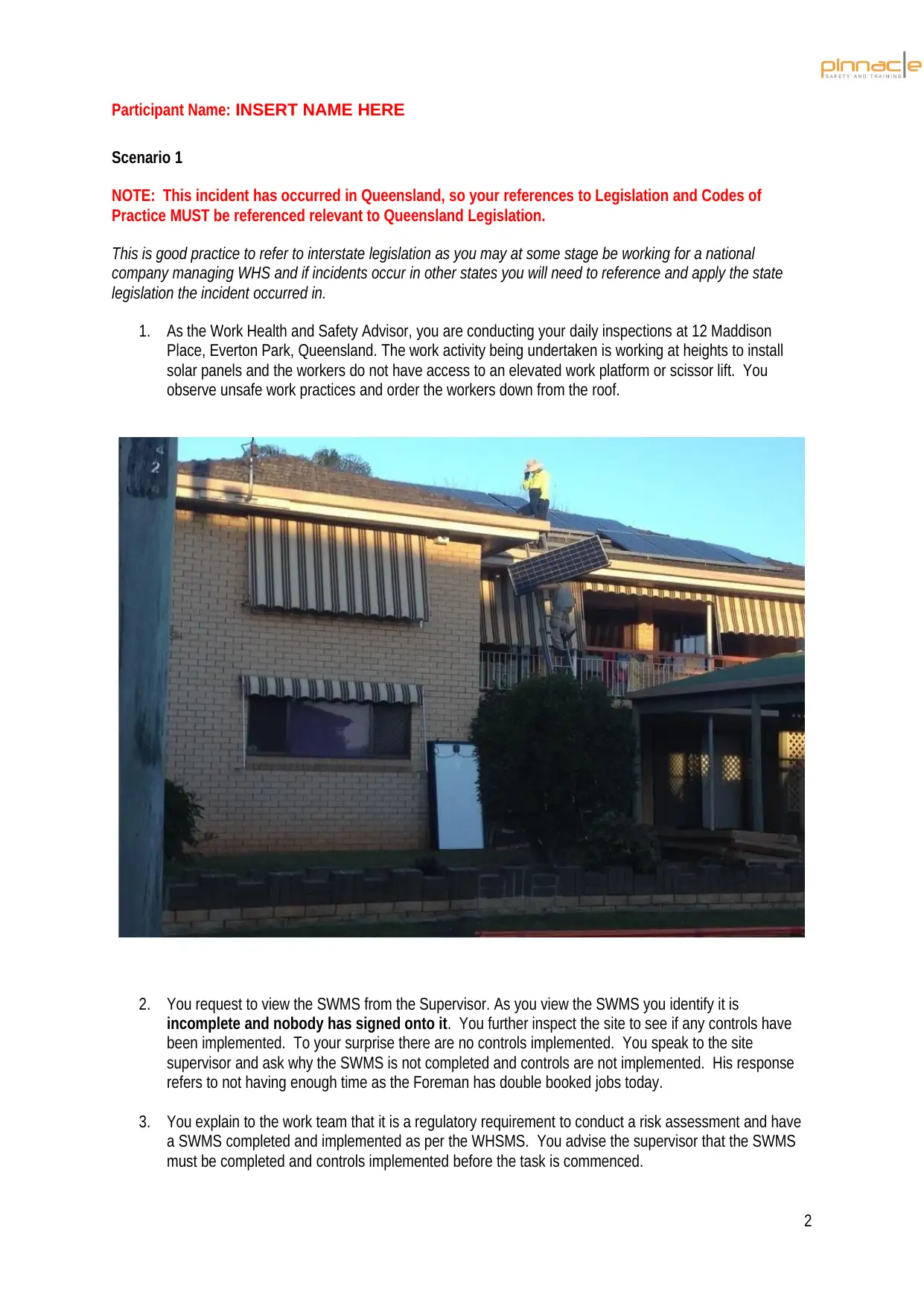
Participant Name: INSERT NAME HERE
Scenario 1
NOTE: This incident has occurred in Queensland, so your references to Legislation and Codes of
Practice MUST be referenced relevant to Queensland Legislation.
This is good practice to refer to interstate legislation as you may at some stage be working for a national
company managing WHS and if incidents occur in other states you will need to reference and apply the state
legislation the incident occurred in.
1. As the Work Health and Safety Advisor, you are conducting your daily inspections at 12 Maddison
Place, Everton Park, Queensland. The work activity being undertaken is working at heights to install
solar panels and the workers do not have access to an elevated work platform or scissor lift. You
observe unsafe work practices and order the workers down from the roof.
2. You request to view the SWMS from the Supervisor. As you view the SWMS you identify it is
incomplete and nobody has signed onto it. You further inspect the site to see if any controls have
been implemented. To your surprise there are no controls implemented. You speak to the site
supervisor and ask why the SWMS is not completed and controls are not implemented. His response
refers to not having enough time as the Foreman has double booked jobs today.
3. You explain to the work team that it is a regulatory requirement to conduct a risk assessment and have
a SWMS completed and implemented as per the WHSMS. You advise the supervisor that the SWMS
must be completed and controls implemented before the task is commenced.
2
Scenario 1
NOTE: This incident has occurred in Queensland, so your references to Legislation and Codes of
Practice MUST be referenced relevant to Queensland Legislation.
This is good practice to refer to interstate legislation as you may at some stage be working for a national
company managing WHS and if incidents occur in other states you will need to reference and apply the state
legislation the incident occurred in.
1. As the Work Health and Safety Advisor, you are conducting your daily inspections at 12 Maddison
Place, Everton Park, Queensland. The work activity being undertaken is working at heights to install
solar panels and the workers do not have access to an elevated work platform or scissor lift. You
observe unsafe work practices and order the workers down from the roof.
2. You request to view the SWMS from the Supervisor. As you view the SWMS you identify it is
incomplete and nobody has signed onto it. You further inspect the site to see if any controls have
been implemented. To your surprise there are no controls implemented. You speak to the site
supervisor and ask why the SWMS is not completed and controls are not implemented. His response
refers to not having enough time as the Foreman has double booked jobs today.
3. You explain to the work team that it is a regulatory requirement to conduct a risk assessment and have
a SWMS completed and implemented as per the WHSMS. You advise the supervisor that the SWMS
must be completed and controls implemented before the task is commenced.
2

Participant Name: INSERT NAME HERE
You take this opportunity to coach the work team on why a SWMS is needed and that the SWMS
is to be completed before the task in undertaken. Complete the following Safe Work Method
Statement.
3
You take this opportunity to coach the work team on why a SWMS is needed and that the SWMS
is to be completed before the task in undertaken. Complete the following Safe Work Method
Statement.
3
⊘ This is a preview!⊘
Do you want full access?
Subscribe today to unlock all pages.

Trusted by 1+ million students worldwide
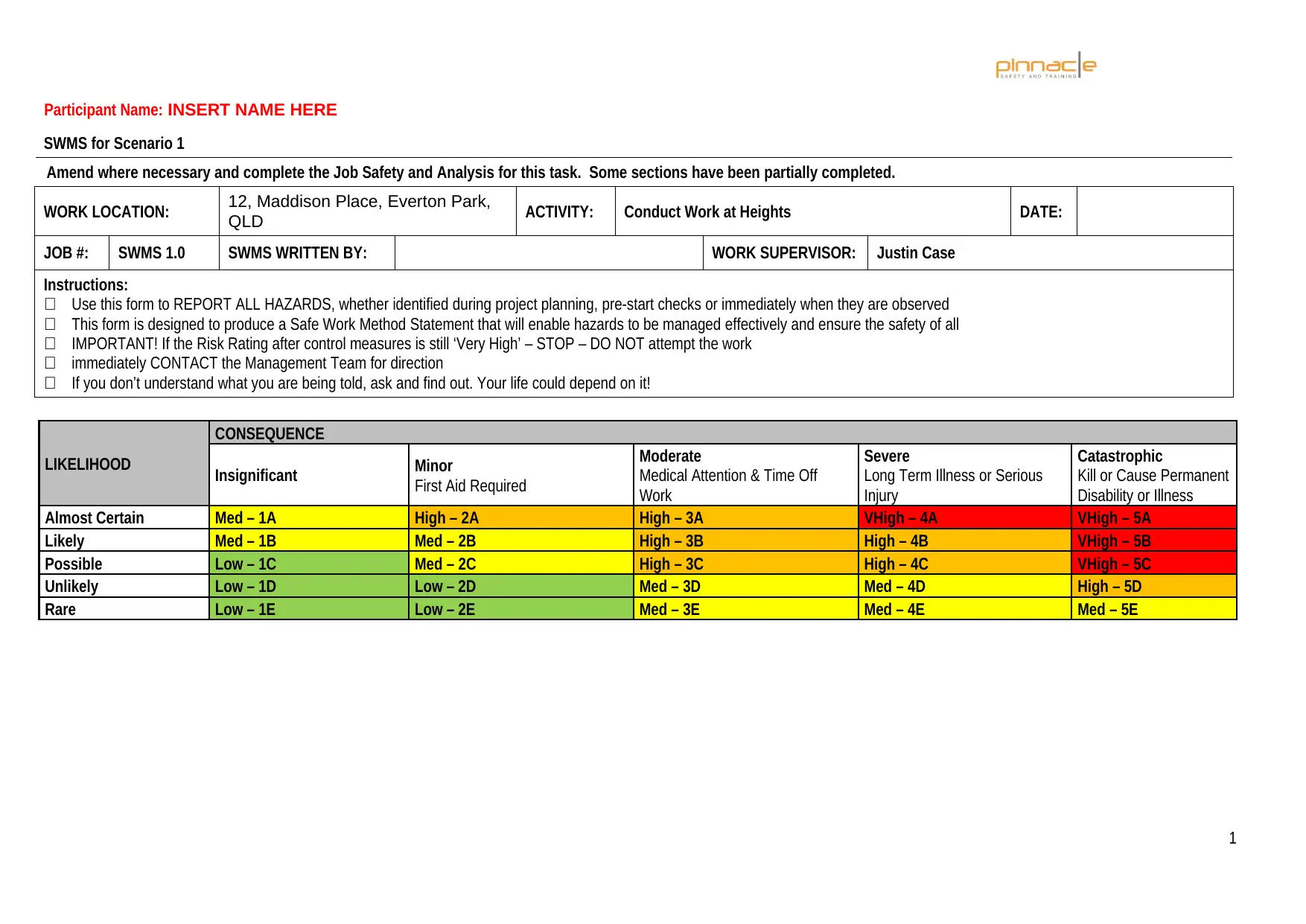
Participant Name: INSERT NAME HERE
SWMS for Scenario 1
Amend where necessary and complete the Job Safety and Analysis for this task. Some sections have been partially completed.
WORK LOCATION: 12, Maddison Place, Everton Park,
QLD ACTIVITY: Conduct Work at Heights DATE:
JOB #: SWMS 1.0 SWMS WRITTEN BY: WORK SUPERVISOR: Justin Case
Instructions:
Use this form to REPORT ALL HAZARDS, whether identified during project planning, pre-start checks or immediately when they are observed
This form is designed to produce a Safe Work Method Statement that will enable hazards to be managed effectively and ensure the safety of all
IMPORTANT! If the Risk Rating after control measures is still ‘Very High’ – STOP – DO NOT attempt the work
immediately CONTACT the Management Team for direction
If you don’t understand what you are being told, ask and find out. Your life could depend on it!
LIKELIHOOD
CONSEQUENCE
Insignificant Minor
First Aid Required
Moderate
Medical Attention & Time Off
Work
Severe
Long Term Illness or Serious
Injury
Catastrophic
Kill or Cause Permanent
Disability or Illness
Almost Certain Med – 1A High – 2A High – 3A VHigh – 4A VHigh – 5A
Likely Med – 1B Med – 2B High – 3B High – 4B VHigh – 5B
Possible Low – 1C Med – 2C High – 3C High – 4C VHigh – 5C
Unlikely Low – 1D Low – 2D Med – 3D Med – 4D High – 5D
Rare Low – 1E Low – 2E Med – 3E Med – 4E Med – 5E
1
SWMS for Scenario 1
Amend where necessary and complete the Job Safety and Analysis for this task. Some sections have been partially completed.
WORK LOCATION: 12, Maddison Place, Everton Park,
QLD ACTIVITY: Conduct Work at Heights DATE:
JOB #: SWMS 1.0 SWMS WRITTEN BY: WORK SUPERVISOR: Justin Case
Instructions:
Use this form to REPORT ALL HAZARDS, whether identified during project planning, pre-start checks or immediately when they are observed
This form is designed to produce a Safe Work Method Statement that will enable hazards to be managed effectively and ensure the safety of all
IMPORTANT! If the Risk Rating after control measures is still ‘Very High’ – STOP – DO NOT attempt the work
immediately CONTACT the Management Team for direction
If you don’t understand what you are being told, ask and find out. Your life could depend on it!
LIKELIHOOD
CONSEQUENCE
Insignificant Minor
First Aid Required
Moderate
Medical Attention & Time Off
Work
Severe
Long Term Illness or Serious
Injury
Catastrophic
Kill or Cause Permanent
Disability or Illness
Almost Certain Med – 1A High – 2A High – 3A VHigh – 4A VHigh – 5A
Likely Med – 1B Med – 2B High – 3B High – 4B VHigh – 5B
Possible Low – 1C Med – 2C High – 3C High – 4C VHigh – 5C
Unlikely Low – 1D Low – 2D Med – 3D Med – 4D High – 5D
Rare Low – 1E Low – 2E Med – 3E Med – 4E Med – 5E
1
Paraphrase This Document
Need a fresh take? Get an instant paraphrase of this document with our AI Paraphraser
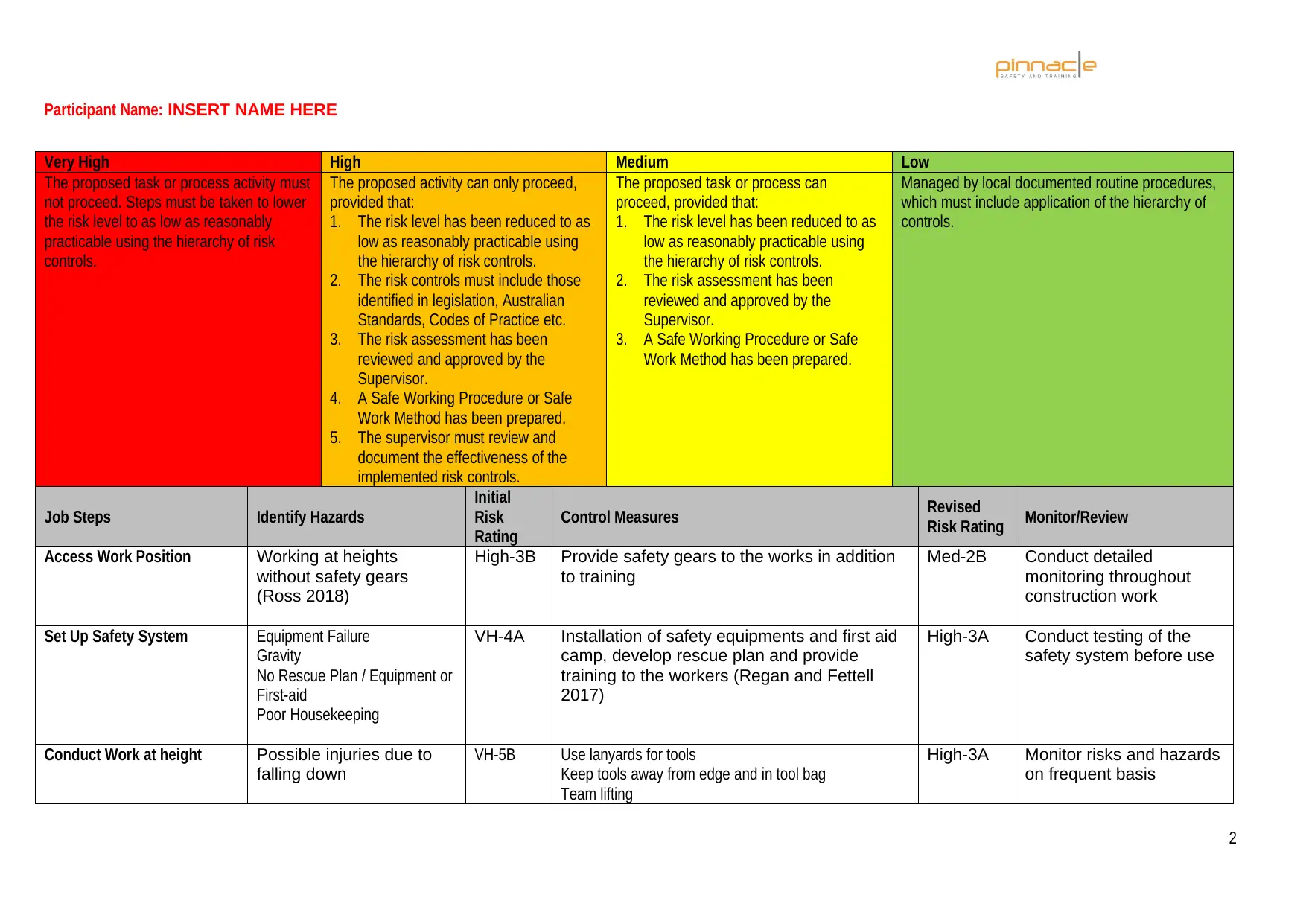
Participant Name: INSERT NAME HERE
Very High High Medium Low
The proposed task or process activity must
not proceed. Steps must be taken to lower
the risk level to as low as reasonably
practicable using the hierarchy of risk
controls.
The proposed activity can only proceed,
provided that:
1. The risk level has been reduced to as
low as reasonably practicable using
the hierarchy of risk controls.
2. The risk controls must include those
identified in legislation, Australian
Standards, Codes of Practice etc.
3. The risk assessment has been
reviewed and approved by the
Supervisor.
4. A Safe Working Procedure or Safe
Work Method has been prepared.
5. The supervisor must review and
document the effectiveness of the
implemented risk controls.
The proposed task or process can
proceed, provided that:
1. The risk level has been reduced to as
low as reasonably practicable using
the hierarchy of risk controls.
2. The risk assessment has been
reviewed and approved by the
Supervisor.
3. A Safe Working Procedure or Safe
Work Method has been prepared.
Managed by local documented routine procedures,
which must include application of the hierarchy of
controls.
Job Steps Identify Hazards
Initial
Risk
Rating
Control Measures Revised
Risk Rating Monitor/Review
Access Work Position Working at heights
without safety gears
(Ross 2018)
High-3B Provide safety gears to the works in addition
to training
Med-2B Conduct detailed
monitoring throughout
construction work
Set Up Safety System Equipment Failure
Gravity
No Rescue Plan / Equipment or
First-aid
Poor Housekeeping
VH-4A Installation of safety equipments and first aid
camp, develop rescue plan and provide
training to the workers (Regan and Fettell
2017)
High-3A Conduct testing of the
safety system before use
Conduct Work at height Possible injuries due to
falling down
VH-5B Use lanyards for tools
Keep tools away from edge and in tool bag
Team lifting
High-3A Monitor risks and hazards
on frequent basis
2
Very High High Medium Low
The proposed task or process activity must
not proceed. Steps must be taken to lower
the risk level to as low as reasonably
practicable using the hierarchy of risk
controls.
The proposed activity can only proceed,
provided that:
1. The risk level has been reduced to as
low as reasonably practicable using
the hierarchy of risk controls.
2. The risk controls must include those
identified in legislation, Australian
Standards, Codes of Practice etc.
3. The risk assessment has been
reviewed and approved by the
Supervisor.
4. A Safe Working Procedure or Safe
Work Method has been prepared.
5. The supervisor must review and
document the effectiveness of the
implemented risk controls.
The proposed task or process can
proceed, provided that:
1. The risk level has been reduced to as
low as reasonably practicable using
the hierarchy of risk controls.
2. The risk assessment has been
reviewed and approved by the
Supervisor.
3. A Safe Working Procedure or Safe
Work Method has been prepared.
Managed by local documented routine procedures,
which must include application of the hierarchy of
controls.
Job Steps Identify Hazards
Initial
Risk
Rating
Control Measures Revised
Risk Rating Monitor/Review
Access Work Position Working at heights
without safety gears
(Ross 2018)
High-3B Provide safety gears to the works in addition
to training
Med-2B Conduct detailed
monitoring throughout
construction work
Set Up Safety System Equipment Failure
Gravity
No Rescue Plan / Equipment or
First-aid
Poor Housekeeping
VH-4A Installation of safety equipments and first aid
camp, develop rescue plan and provide
training to the workers (Regan and Fettell
2017)
High-3A Conduct testing of the
safety system before use
Conduct Work at height Possible injuries due to
falling down
VH-5B Use lanyards for tools
Keep tools away from edge and in tool bag
Team lifting
High-3A Monitor risks and hazards
on frequent basis
2
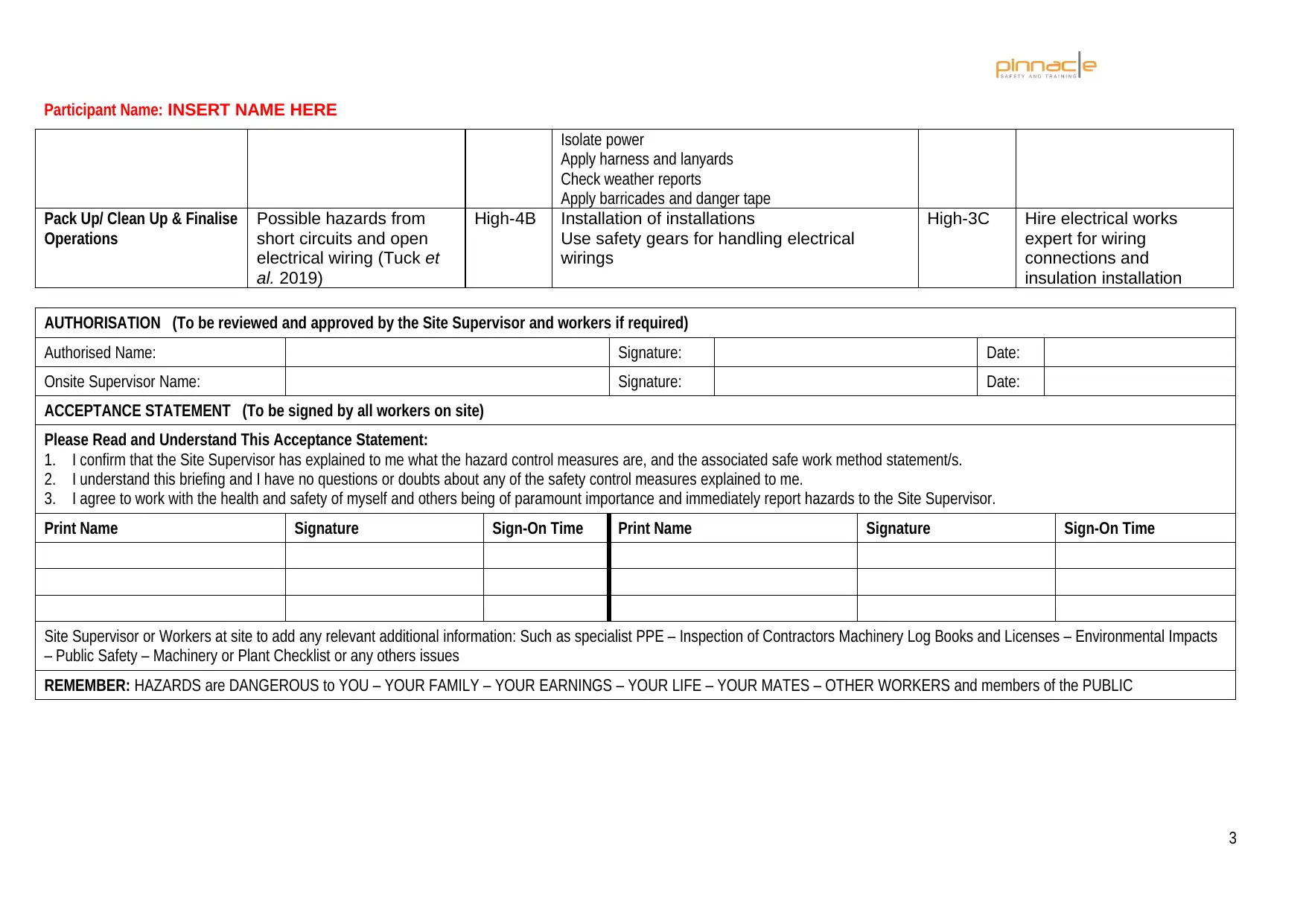
Participant Name: INSERT NAME HERE
Isolate power
Apply harness and lanyards
Check weather reports
Apply barricades and danger tape
Pack Up/ Clean Up & Finalise
Operations
Possible hazards from
short circuits and open
electrical wiring (Tuck et
al. 2019)
High-4B Installation of installations
Use safety gears for handling electrical
wirings
High-3C Hire electrical works
expert for wiring
connections and
insulation installation
AUTHORISATION (To be reviewed and approved by the Site Supervisor and workers if required)
Authorised Name: Signature: Date:
Onsite Supervisor Name: Signature: Date:
ACCEPTANCE STATEMENT (To be signed by all workers on site)
Please Read and Understand This Acceptance Statement:
1. I confirm that the Site Supervisor has explained to me what the hazard control measures are, and the associated safe work method statement/s.
2. I understand this briefing and I have no questions or doubts about any of the safety control measures explained to me.
3. I agree to work with the health and safety of myself and others being of paramount importance and immediately report hazards to the Site Supervisor.
Print Name Signature Sign-On Time Print Name Signature Sign-On Time
Site Supervisor or Workers at site to add any relevant additional information: Such as specialist PPE – Inspection of Contractors Machinery Log Books and Licenses – Environmental Impacts
– Public Safety – Machinery or Plant Checklist or any others issues
REMEMBER: HAZARDS are DANGEROUS to YOU – YOUR FAMILY – YOUR EARNINGS – YOUR LIFE – YOUR MATES – OTHER WORKERS and members of the PUBLIC
3
Isolate power
Apply harness and lanyards
Check weather reports
Apply barricades and danger tape
Pack Up/ Clean Up & Finalise
Operations
Possible hazards from
short circuits and open
electrical wiring (Tuck et
al. 2019)
High-4B Installation of installations
Use safety gears for handling electrical
wirings
High-3C Hire electrical works
expert for wiring
connections and
insulation installation
AUTHORISATION (To be reviewed and approved by the Site Supervisor and workers if required)
Authorised Name: Signature: Date:
Onsite Supervisor Name: Signature: Date:
ACCEPTANCE STATEMENT (To be signed by all workers on site)
Please Read and Understand This Acceptance Statement:
1. I confirm that the Site Supervisor has explained to me what the hazard control measures are, and the associated safe work method statement/s.
2. I understand this briefing and I have no questions or doubts about any of the safety control measures explained to me.
3. I agree to work with the health and safety of myself and others being of paramount importance and immediately report hazards to the Site Supervisor.
Print Name Signature Sign-On Time Print Name Signature Sign-On Time
Site Supervisor or Workers at site to add any relevant additional information: Such as specialist PPE – Inspection of Contractors Machinery Log Books and Licenses – Environmental Impacts
– Public Safety – Machinery or Plant Checklist or any others issues
REMEMBER: HAZARDS are DANGEROUS to YOU – YOUR FAMILY – YOUR EARNINGS – YOUR LIFE – YOUR MATES – OTHER WORKERS and members of the PUBLIC
3
⊘ This is a preview!⊘
Do you want full access?
Subscribe today to unlock all pages.

Trusted by 1+ million students worldwide
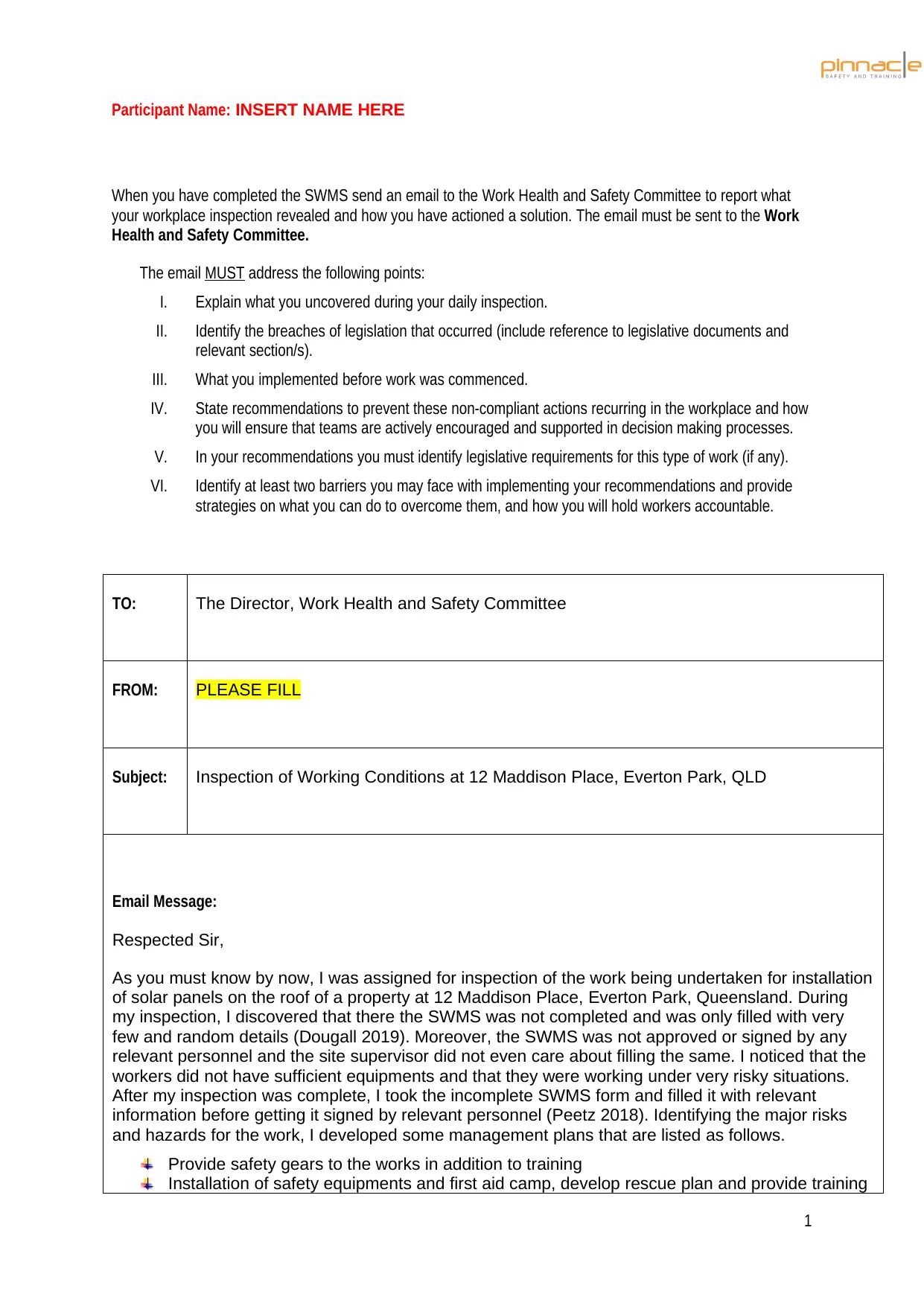
Participant Name: INSERT NAME HERE
When you have completed the SWMS send an email to the Work Health and Safety Committee to report what
your workplace inspection revealed and how you have actioned a solution. The email must be sent to the Work
Health and Safety Committee.
The email MUST address the following points:
I. Explain what you uncovered during your daily inspection.
II. Identify the breaches of legislation that occurred (include reference to legislative documents and
relevant section/s).
III. What you implemented before work was commenced.
IV. State recommendations to prevent these non-compliant actions recurring in the workplace and how
you will ensure that teams are actively encouraged and supported in decision making processes.
V. In your recommendations you must identify legislative requirements for this type of work (if any).
VI. Identify at least two barriers you may face with implementing your recommendations and provide
strategies on what you can do to overcome them, and how you will hold workers accountable.
TO: The Director, Work Health and Safety Committee
FROM: PLEASE FILL
Subject: Inspection of Working Conditions at 12 Maddison Place, Everton Park, QLD
Email Message:
Respected Sir,
As you must know by now, I was assigned for inspection of the work being undertaken for installation
of solar panels on the roof of a property at 12 Maddison Place, Everton Park, Queensland. During
my inspection, I discovered that there the SWMS was not completed and was only filled with very
few and random details (Dougall 2019). Moreover, the SWMS was not approved or signed by any
relevant personnel and the site supervisor did not even care about filling the same. I noticed that the
workers did not have sufficient equipments and that they were working under very risky situations.
After my inspection was complete, I took the incomplete SWMS form and filled it with relevant
information before getting it signed by relevant personnel (Peetz 2018). Identifying the major risks
and hazards for the work, I developed some management plans that are listed as follows.
Provide safety gears to the works in addition to training
Installation of safety equipments and first aid camp, develop rescue plan and provide training
1
When you have completed the SWMS send an email to the Work Health and Safety Committee to report what
your workplace inspection revealed and how you have actioned a solution. The email must be sent to the Work
Health and Safety Committee.
The email MUST address the following points:
I. Explain what you uncovered during your daily inspection.
II. Identify the breaches of legislation that occurred (include reference to legislative documents and
relevant section/s).
III. What you implemented before work was commenced.
IV. State recommendations to prevent these non-compliant actions recurring in the workplace and how
you will ensure that teams are actively encouraged and supported in decision making processes.
V. In your recommendations you must identify legislative requirements for this type of work (if any).
VI. Identify at least two barriers you may face with implementing your recommendations and provide
strategies on what you can do to overcome them, and how you will hold workers accountable.
TO: The Director, Work Health and Safety Committee
FROM: PLEASE FILL
Subject: Inspection of Working Conditions at 12 Maddison Place, Everton Park, QLD
Email Message:
Respected Sir,
As you must know by now, I was assigned for inspection of the work being undertaken for installation
of solar panels on the roof of a property at 12 Maddison Place, Everton Park, Queensland. During
my inspection, I discovered that there the SWMS was not completed and was only filled with very
few and random details (Dougall 2019). Moreover, the SWMS was not approved or signed by any
relevant personnel and the site supervisor did not even care about filling the same. I noticed that the
workers did not have sufficient equipments and that they were working under very risky situations.
After my inspection was complete, I took the incomplete SWMS form and filled it with relevant
information before getting it signed by relevant personnel (Peetz 2018). Identifying the major risks
and hazards for the work, I developed some management plans that are listed as follows.
Provide safety gears to the works in addition to training
Installation of safety equipments and first aid camp, develop rescue plan and provide training
1
Paraphrase This Document
Need a fresh take? Get an instant paraphrase of this document with our AI Paraphraser
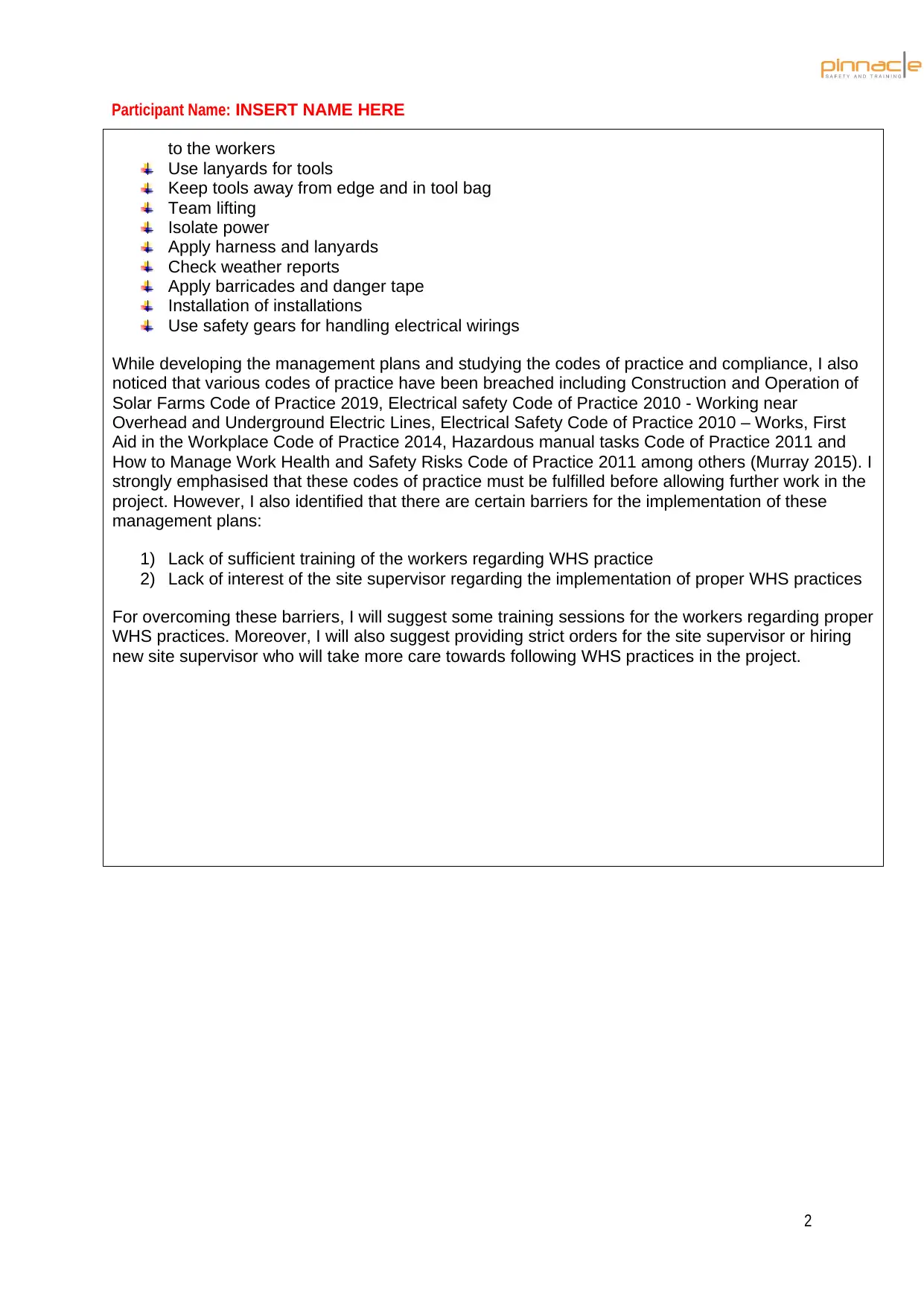
Participant Name: INSERT NAME HERE
to the workers
Use lanyards for tools
Keep tools away from edge and in tool bag
Team lifting
Isolate power
Apply harness and lanyards
Check weather reports
Apply barricades and danger tape
Installation of installations
Use safety gears for handling electrical wirings
While developing the management plans and studying the codes of practice and compliance, I also
noticed that various codes of practice have been breached including Construction and Operation of
Solar Farms Code of Practice 2019, Electrical safety Code of Practice 2010 - Working near
Overhead and Underground Electric Lines, Electrical Safety Code of Practice 2010 – Works, First
Aid in the Workplace Code of Practice 2014, Hazardous manual tasks Code of Practice 2011 and
How to Manage Work Health and Safety Risks Code of Practice 2011 among others (Murray 2015). I
strongly emphasised that these codes of practice must be fulfilled before allowing further work in the
project. However, I also identified that there are certain barriers for the implementation of these
management plans:
1) Lack of sufficient training of the workers regarding WHS practice
2) Lack of interest of the site supervisor regarding the implementation of proper WHS practices
For overcoming these barriers, I will suggest some training sessions for the workers regarding proper
WHS practices. Moreover, I will also suggest providing strict orders for the site supervisor or hiring
new site supervisor who will take more care towards following WHS practices in the project.
2
to the workers
Use lanyards for tools
Keep tools away from edge and in tool bag
Team lifting
Isolate power
Apply harness and lanyards
Check weather reports
Apply barricades and danger tape
Installation of installations
Use safety gears for handling electrical wirings
While developing the management plans and studying the codes of practice and compliance, I also
noticed that various codes of practice have been breached including Construction and Operation of
Solar Farms Code of Practice 2019, Electrical safety Code of Practice 2010 - Working near
Overhead and Underground Electric Lines, Electrical Safety Code of Practice 2010 – Works, First
Aid in the Workplace Code of Practice 2014, Hazardous manual tasks Code of Practice 2011 and
How to Manage Work Health and Safety Risks Code of Practice 2011 among others (Murray 2015). I
strongly emphasised that these codes of practice must be fulfilled before allowing further work in the
project. However, I also identified that there are certain barriers for the implementation of these
management plans:
1) Lack of sufficient training of the workers regarding WHS practice
2) Lack of interest of the site supervisor regarding the implementation of proper WHS practices
For overcoming these barriers, I will suggest some training sessions for the workers regarding proper
WHS practices. Moreover, I will also suggest providing strict orders for the site supervisor or hiring
new site supervisor who will take more care towards following WHS practices in the project.
2
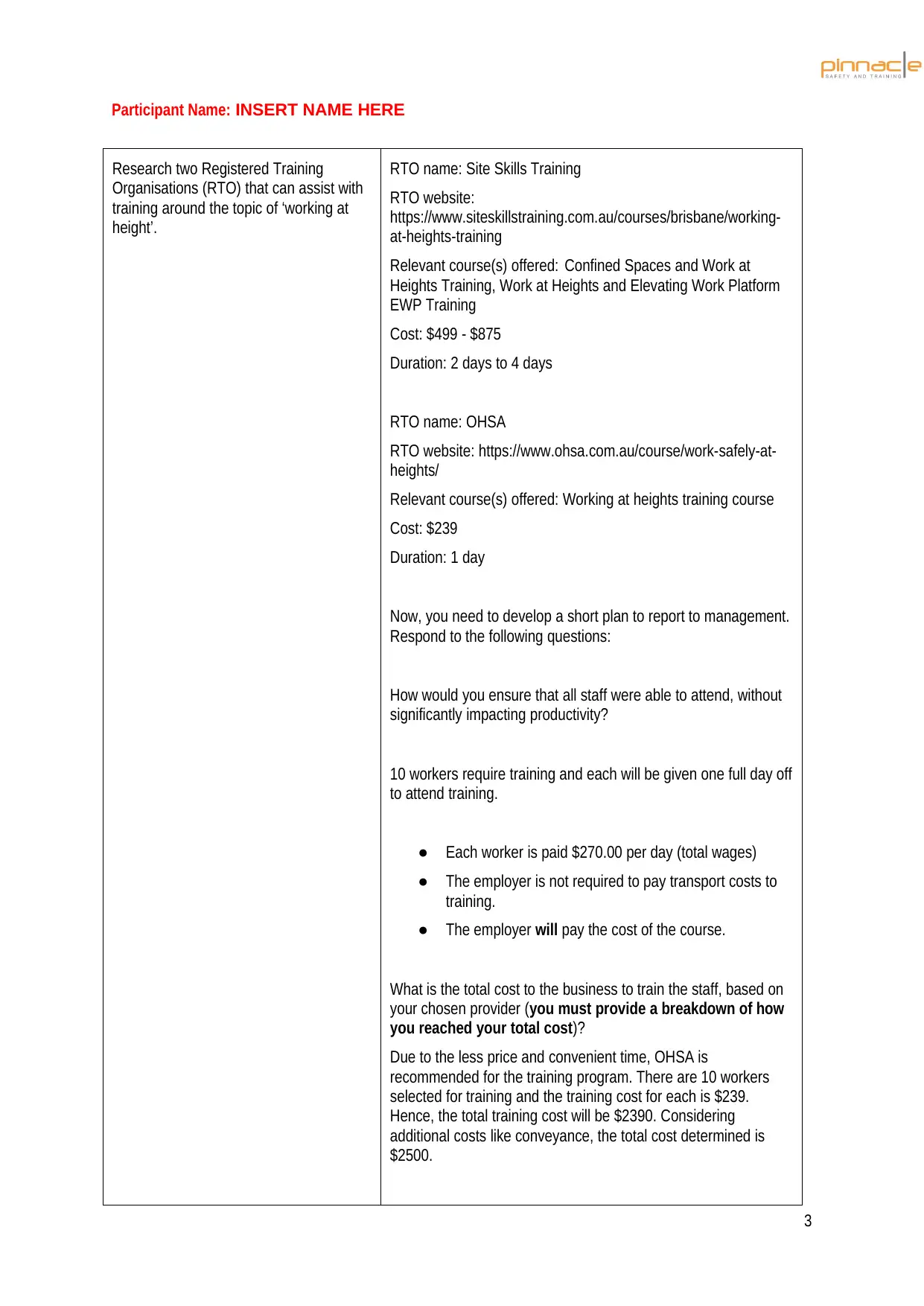
Participant Name: INSERT NAME HERE
Research two Registered Training
Organisations (RTO) that can assist with
training around the topic of ‘working at
height’.
RTO name: Site Skills Training
RTO website:
https://www.siteskillstraining.com.au/courses/brisbane/working-
at-heights-training
Relevant course(s) offered: Confined Spaces and Work at
Heights Training, Work at Heights and Elevating Work Platform
EWP Training
Cost: $499 - $875
Duration: 2 days to 4 days
RTO name: OHSA
RTO website: https://www.ohsa.com.au/course/work-safely-at-
heights/
Relevant course(s) offered: Working at heights training course
Cost: $239
Duration: 1 day
Now, you need to develop a short plan to report to management.
Respond to the following questions:
How would you ensure that all staff were able to attend, without
significantly impacting productivity?
10 workers require training and each will be given one full day off
to attend training.
● Each worker is paid $270.00 per day (total wages)
● The employer is not required to pay transport costs to
training.
● The employer will pay the cost of the course.
What is the total cost to the business to train the staff, based on
your chosen provider (you must provide a breakdown of how
you reached your total cost)?
Due to the less price and convenient time, OHSA is
recommended for the training program. There are 10 workers
selected for training and the training cost for each is $239.
Hence, the total training cost will be $2390. Considering
additional costs like conveyance, the total cost determined is
$2500.
3
Research two Registered Training
Organisations (RTO) that can assist with
training around the topic of ‘working at
height’.
RTO name: Site Skills Training
RTO website:
https://www.siteskillstraining.com.au/courses/brisbane/working-
at-heights-training
Relevant course(s) offered: Confined Spaces and Work at
Heights Training, Work at Heights and Elevating Work Platform
EWP Training
Cost: $499 - $875
Duration: 2 days to 4 days
RTO name: OHSA
RTO website: https://www.ohsa.com.au/course/work-safely-at-
heights/
Relevant course(s) offered: Working at heights training course
Cost: $239
Duration: 1 day
Now, you need to develop a short plan to report to management.
Respond to the following questions:
How would you ensure that all staff were able to attend, without
significantly impacting productivity?
10 workers require training and each will be given one full day off
to attend training.
● Each worker is paid $270.00 per day (total wages)
● The employer is not required to pay transport costs to
training.
● The employer will pay the cost of the course.
What is the total cost to the business to train the staff, based on
your chosen provider (you must provide a breakdown of how
you reached your total cost)?
Due to the less price and convenient time, OHSA is
recommended for the training program. There are 10 workers
selected for training and the training cost for each is $239.
Hence, the total training cost will be $2390. Considering
additional costs like conveyance, the total cost determined is
$2500.
3
⊘ This is a preview!⊘
Do you want full access?
Subscribe today to unlock all pages.

Trusted by 1+ million students worldwide
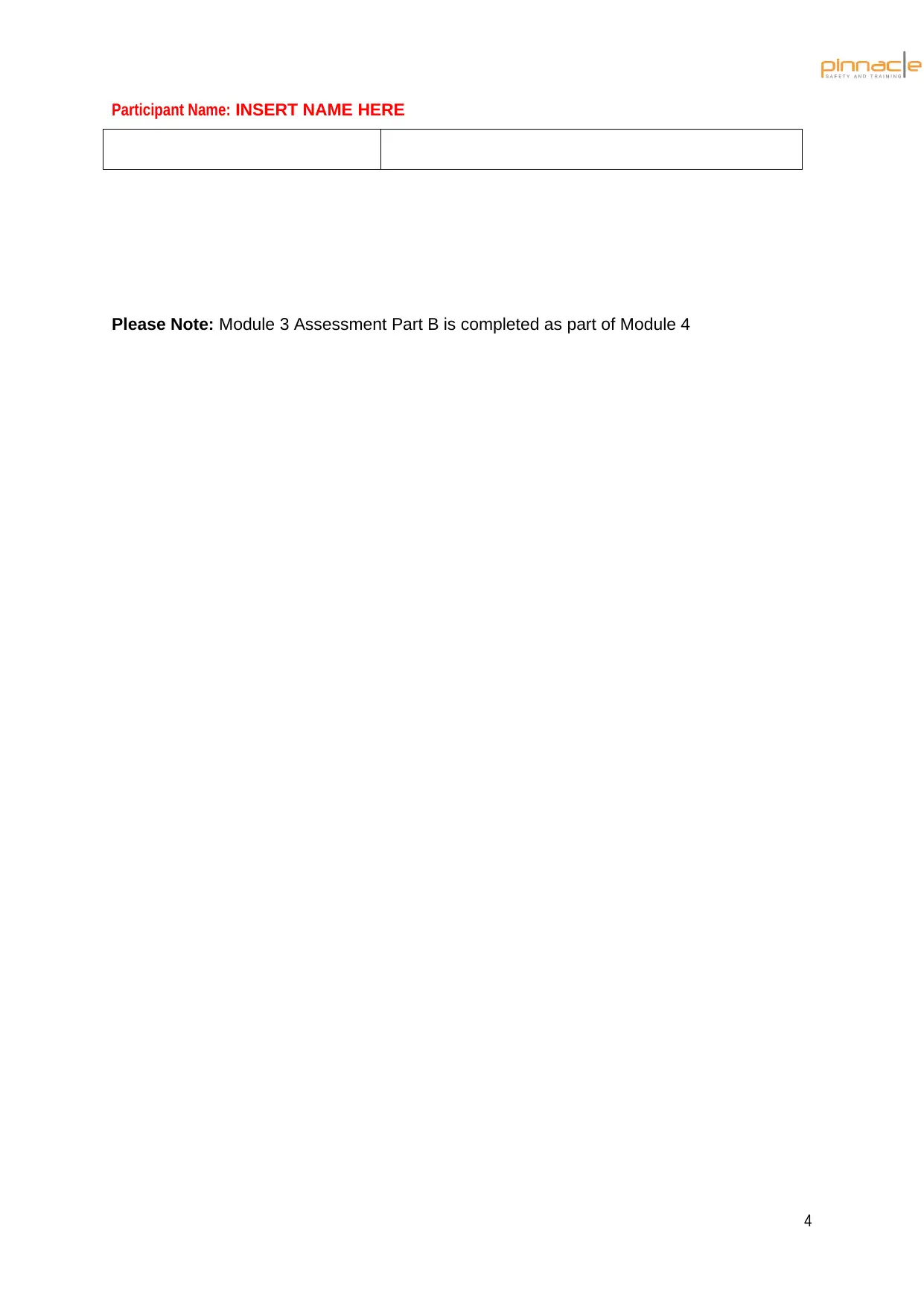
Participant Name: INSERT NAME HERE
Please Note: Module 3 Assessment Part B is completed as part of Module 4
4
Please Note: Module 3 Assessment Part B is completed as part of Module 4
4
1 out of 10
Related Documents
Your All-in-One AI-Powered Toolkit for Academic Success.
+13062052269
info@desklib.com
Available 24*7 on WhatsApp / Email
![[object Object]](/_next/static/media/star-bottom.7253800d.svg)
Unlock your academic potential
Copyright © 2020–2025 A2Z Services. All Rights Reserved. Developed and managed by ZUCOL.





